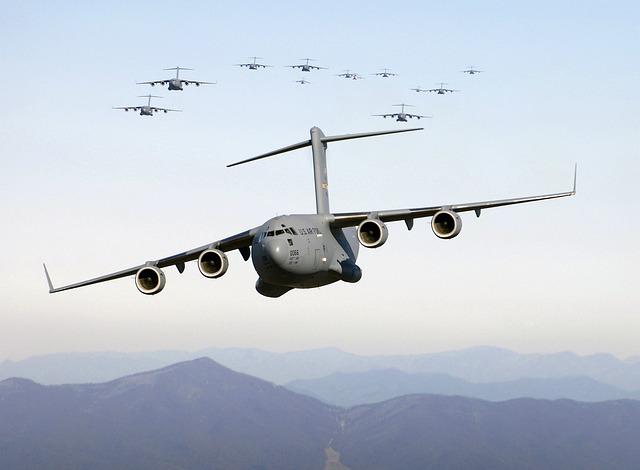Introduction: The U.S. Space Forces - Europe & Africa: A New frontier in Defense
In an era where technological advancements are reshaping the landscape of modern warfare,the U.S. Space Forces – Europe & Africa (USSF-EA) stand at the forefront of America’s strategic efforts to secure and dominate the final frontier. Established as part of a broader initiative to integrate space operations within the Department of Defense, USSF-EA plays a critical role in ensuring that the United States maintains superiority in an increasingly contested space habitat. This article delves into the mission,structure,and significance of the U.S. Space Forces in Europe and Africa, exploring how they contribute to national security and foster international partnerships in the realm of space exploration and utilization. As the lines separating terrestrial and extraterrestrial operations blur,understanding the role of these forces becomes essential for grasping the future of military engagement in the 21st century.
Understanding the Mission of U.S. space Forces in Europe and Africa
The U.S. Space Forces in Europe and Africa are dedicated to safeguarding national interests in an increasingly contested space environment. This mission encompasses a variety of critical operations, including:
Space Operations: Ensuring the safety, security, and sustainability of U.S. space assets.
Collaboration: Partnering with NATO allies and international partners to develop collective space capabilities.
Strategic Support: Providing essential space-based intelligence, surveillance, and reconnaissance to ground forces.
Through a combination of advanced technologies and collaborative efforts, U.S. space Forces aim to maintain a strategic advantage. This is achieved by:
Developing Resilience: Enhancing the ability to operate in contested and denied environments.
Innovating Solutions: Leveraging cutting-edge research to advance space technology.
Training Forces: Equipping military personnel with the knowledge and skills to navigate complex space operations.
Key Focus Areas
Description
Strategic deterrence
Maintaining a credible space deterrent to protect U.S. and allied interests.
Space Domain Awareness
Monitoring and assessing threats in space.
Integrated Operations
Ensuring seamless integration of space capabilities across military operations.
Key Strategic Objectives for Space Operations in Transatlantic Security
The evolving landscape of transatlantic security demands a robust and coordinated approach to space operations that enhances collective defense and deterrence capabilities. Key strategic objectives aim to ensure that the U.S. Space Forces, in collaboration with allied nations, are prepared to address various challenges in space, counter hostile actions, and protect critical infrastructure. Central to this effort is the establishment of a thorough framework that facilitates details sharing and operational synchronization among NATO allies, thus bolstering response mechanisms against aggressive maneuvers in space.
In pursuit of these objectives,the focus will be directed towards:
Enhancing situational awareness: Developing advanced reconnaissance and surveillance systems to monitor spacecraft and potential threats.
Building resilient space infrastructure: Investing in technologies that ensure the durability and reliability of crucial satellite systems.
strengthening allied partnerships: Facilitating joint exercises and training programs to cultivate interoperability among joint forces.
Advancing space policy and governance: Collaborating on international regulations to promote the peaceful use of space and mitigate conflicts.
Strategic Focus Area
Expected Outcome
Surveillance Enhancements
Improved threat detection
Infrastructure Investment
Increased operational durability
Joint Operations
Enhanced interoperability
International collaboration
Stronger governance frameworks
The Role of International Collaboration in Space Defense
International collaboration plays a pivotal role in the realm of space defense, fostering a robust network of partners committed to ensuring the safety and security of both national and global assets in outer space. As threats in this domain grow increasingly complex, cooperative frameworks enable sharing of vital information, advanced technologies, and strategic insights. Key aspects of this collaboration include:
Joint Exercises: Regular practice scenarios to enhance operational readiness.
Data Sharing: Partner nations exchanging intelligence on potential threats.
Research & Progress: Collaborative innovation to develop cutting-edge defense technologies.
Partnerships not only enhance capabilities but also ensure a unified response to any escalating challenge in space. These alliances can be further illustrated through structured agreements and treaties that guide cooperative efforts. Examples include:
Agreement/treaty
Participating Countries
focus Area
Outer space Treaty
Over 100 nations
Peaceful use of outer space
U.S.-Japan security Alliance
U.S., Japan
Space situational awareness
european Space Agency Cooperation
22 European nations
Joint space missions
Advancements in Technology and Their Impact on Space Forces
Recent advancements in technology are considerably transforming the operational capabilities of space forces across the globe, notably within the U.S. Space Forces in Europe and Africa. Enhanced satellite systems,artificial intelligence,and improved data analytics are facilitating unprecedented levels of efficiency and strategic decision-making. Key innovations include:
Next-Generation Satellites: Equipped with advanced sensors and dialogue capabilities,allowing for real-time data sharing and enhanced surveillance.
Artificial Intelligence (AI): Used for predictive analytics,enabling quicker response times and autonomous decision-making processes.
Cybersecurity Enhancements: Ensures the integrity of space-based assets against increasing cyber threats.
The integration of these technologies not only bolsters national security but also fosters collaboration with international allies. The following table summarizes the impact of these advancements on mission effectiveness:
Technology
Impact
Advanced Communication Systems
Improved coordination and intelligence sharing
Robotic Systems
Enhanced operational reach without human risk
Space Situational Awareness Tools
proactive threat detection and mitigation
As technological landscapes evolve, the U.S. Space Forces are committed to leveraging these advancements to ensure mission success, reinforce deterrence, and maintain superiority in an
Future Challenges: Navigating Geopolitical Dynamics in Space
As the geopolitical landscape continues to evolve, the significance of space as a domain for international interaction cannot be overstated. Nations are increasingly recognizing that advancements in technology and the military capabilities surrounding space will shape the balance of power in future conflicts.the U.S. Space Forces in Europe and Africa stand at the forefront of this dynamic environment,focusing on collaboration and partnership with allied nations to address shared security concerns and operational challenges. This collaborative approach aims to foster mutual understanding, increase strategic interoperability, and ensure that space remains an arena for peace rather than conflict.
The following factors illustrate the complexities of navigating the geopolitical dynamics in space:
Competition for Resources: Access to space is essential for national security, economic growth, and technological advancement.Nations are vying for critical resources, such as satellite bandwidth and orbital slots.
Space Debris Management: The increasing number of active satellites raises concerns over space debris and the potential for collisions, necessitating international cooperation for sustainable space operations.
Regulatory Frameworks: Establishing robust policies and treaties that govern the use of space will be crucial in mitigating conflicts and ensuring compliance with international law.
challenge
Strategic Response
Interference with Satellite Operations
Enhanced cybersecurity measures
Military Escalation in Space
Diplomatic engagements with adversaries
Technological Supremacy
Investment in research and innovation
Recommendations for Enhancing Operational Readiness and Joint Exercises
To elevate operational readiness in space missions, continuous evaluation and adaptations of training methodologies are essential. Incorporating realistic scenarios that mimic potential threats faced in contemporary space operations will enable personnel to develop essential skills for effective decision-making under pressure. The Space Forces can benefit from integrating advanced simulation technologies and virtual reality platforms to facilitate high-stakes environments that encourage teamwork and communication. Additionally, fostering partnerships with allied nations through joint exercises can enhance interoperability and share best practices across the board.
Furthermore, establishing a robust feedback mechanism post-exercises can lead to significant improvements in future training sessions. This approach may include:
After-action reviews leveraging insights from key participants
Regular workshops to address identified weaknesses
Cross-training initiatives to broaden skill sets among forces
by implementing innovative practices and promoting a culture of shared learning, the U.S. Space Forces can ensure that their operational preparedness remains unmatched on the global stage. Collaborative exercises not only build resilience and adaptability but also reinforce the strength of alliances formed in pursuit of strategic objectives.
Concluding Remarks
the establishment of the U.S. Space Forces in Europe and Africa marks a pivotal evolution in the strategic landscape of military operations on a global scale. as the demand for space-based capabilities continues to grow, this newly formed branch is poised to enhance the United States’ readiness and resilience in the face of emerging threats. By fostering international partnerships and advancing technological innovations, the Space Forces aim to secure the domain of space, ensuring both national and allied interests are safeguarded. The ongoing developments within this initiative highlight the critical importance of space as a theater of operations in the 21st century. As we move forward, it will be essential to monitor how these forces adapt and respond to the challenges ahead, shaping not just military strategy but the future of global security in the cosmos.
The post About Us > U.S. Space Forces – Europe & Africa – Space Force first appeared on Capital Cities.
Author : Capital-Cities
Publish date : 2025-02-23 14:39:50
Copyright for syndicated content belongs to the linked Source.



